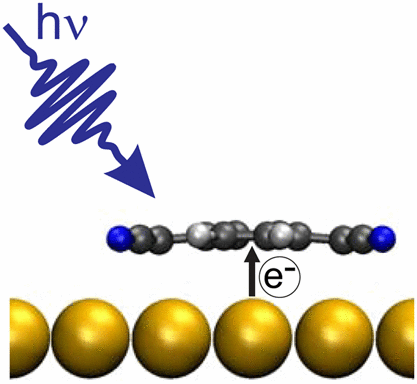当前位置:
X-MOL 学术
›
J. Phys. Chem. Lett.
›
论文详情
Our official English website, www.x-mol.net, welcomes your
feedback! (Note: you will need to create a separate account there.)
Molecular Ion Formation by Photoinduced Electron Transfer at the Tetracyanoquinodimethane/Au(111) Interface
The Journal of Physical Chemistry Letters ( IF 4.8 ) Pub Date : 2017-09-15 00:00:00 , DOI: 10.1021/acs.jpclett.7b01897 David Gerbert 1 , Petra Tegeder 1
The Journal of Physical Chemistry Letters ( IF 4.8 ) Pub Date : 2017-09-15 00:00:00 , DOI: 10.1021/acs.jpclett.7b01897 David Gerbert 1 , Petra Tegeder 1
Affiliation

|
Optically induced processes in organic materials are essential for light harvesting, switching, and sensor technologies. Here we studied the electronic properties of the tetracyanoquinodimethane(TCNQ)/Au(111) interface by using two-photon photoemission spectroscopy. For this interface we demonstrated the lack of charge-transfer interactions, but we found a significant increase in the sample work function due to UV-light illumination, while the electronic structure of the TCNQ-derived states remain unaffected. Thereby the work function of the interface can be tuned over a wide range via the photon dose. We assigned this to a photoinduced metal-to-molecule electron transfer creating negative ions. The electrons are bound by a small potential barrier. Thus thermal activation reverses the process resulting in the original work function value. The presented photoinduced charge transfer at the TCNQ/Au(111) interface can be used for continuous work function tuning across the substrate’s work function, which can be applied in device-adapted hole-injection layers or organic UV-light sensors.
中文翻译:

Tetracyanoquinodimethane / Au(111)界面上的光诱导电子转移形成分子离子
有机材料中的光诱导过程对于光收集,转换和传感器技术至关重要。在这里,我们通过使用双光子光发射光谱学研究了四氰基喹二甲烷(TCNQ)/ Au(111)界面的电子性质。对于该界面,我们证明了电荷转移相互作用的缺乏,但是我们发现由于紫外光照射,样品功函数显着增加,而TCNQ衍生态的电子结构保持不受影响。因此,可以通过光子剂量在很宽的范围内调整界面的功函数。我们将此归因于光诱导的金属到分子的电子转移,产生负离子。电子被一个小的势垒所束缚。因此,热激活使过程逆转,从而产生原始功函数值。
更新日期:2017-09-15
中文翻译:

Tetracyanoquinodimethane / Au(111)界面上的光诱导电子转移形成分子离子
有机材料中的光诱导过程对于光收集,转换和传感器技术至关重要。在这里,我们通过使用双光子光发射光谱学研究了四氰基喹二甲烷(TCNQ)/ Au(111)界面的电子性质。对于该界面,我们证明了电荷转移相互作用的缺乏,但是我们发现由于紫外光照射,样品功函数显着增加,而TCNQ衍生态的电子结构保持不受影响。因此,可以通过光子剂量在很宽的范围内调整界面的功函数。我们将此归因于光诱导的金属到分子的电子转移,产生负离子。电子被一个小的势垒所束缚。因此,热激活使过程逆转,从而产生原始功函数值。











































 京公网安备 11010802027423号
京公网安备 11010802027423号